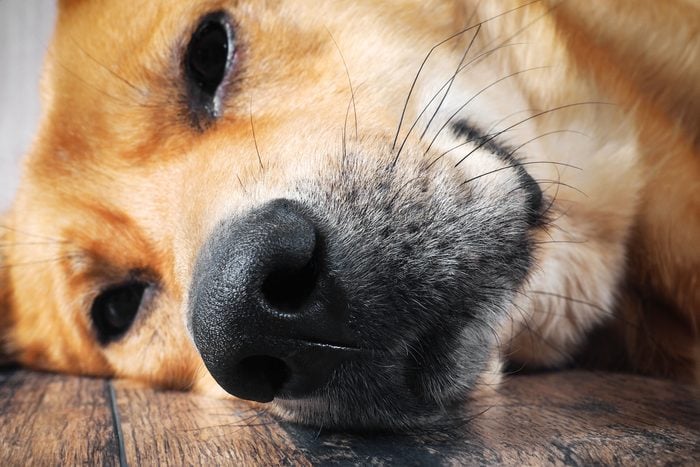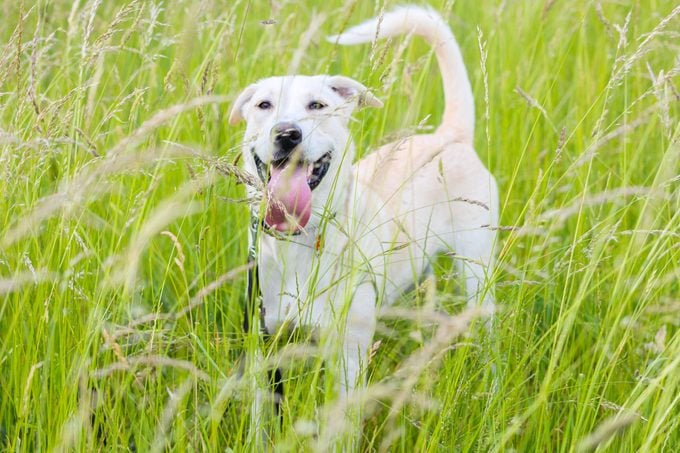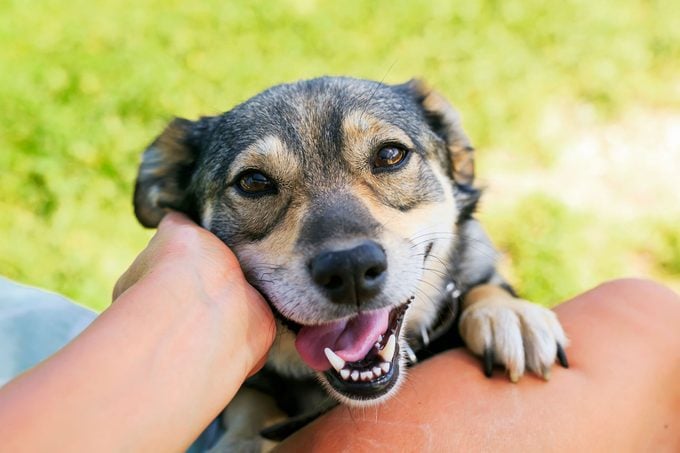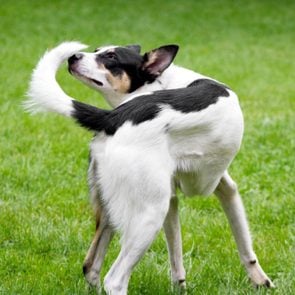Why Do Dogs Have Whiskers? 5 Reasons, According to a Vet
Updated: Apr. 15, 2024

Whiskers aren't just adorable—they also play an important role in your pup's life. Here's everything you need to know about dog whiskers.
When you’ve been a veterinarian for as long as I have (25 years and counting!), you get good at seeing a dog’s point of view. As you learn various dog facts, you start to understand what makes dogs tick, as well as which physical features play a huge role in their daily lives. Whiskers check both of those boxes, and this is why I hate the thought of a dog’s whiskers being trimmed—or worse, plucked. If people knew how important they were to a dog, they’d leave them alone. So why do dogs have whiskers? There are a few reasons, and none of them have to do with a dog’s looks!
Ahead, you’ll learn the reasons dog whiskers exist and gain a newfound appreciation for this undervalued part of a dog’s anatomy, just like I once did.
Get Reader’s Digest’s Read Up newsletter for more pets, humor, cleaning, travel, tech and fun facts all week long.
Do all dogs have whiskers?
Yes! Dog whiskers are so important that all dogs have them, including hairless dog breeds. And while newborn puppies have just the lightest covering of fine fur, they still have whiskers. In short, all dogs have whiskers (officially called vibrissae or tactile hairs) for their entire lives, though their number and length can vary from breed to breed and from individual to individual.
And whiskers don’t just grow around a dog’s muzzle. They’re strategically located all around a dog’s face:
- Mystacial whiskers are found on both sides of a dog’s muzzle.
- Genal whiskers are farther back, on the cheeks.
- Superciliary whiskers (also called supraorbital whiskers) are located above a dog’s eyes.
- Interramal whiskers grow from a single mole under the chin.
Why do dogs have whiskers?
Whiskers are important sensory organs for dogs. Yes, you read that right: They’re actually considered organs. They grow from special follicles that have many more nerve endings than the regular follicles associated with fur, which makes whiskers extremely sensitive. So what do dog whiskers do, exactly? Think of how you use your fingertips when you need to get the most out of your sense of touch—whiskers do the same thing for dogs. And that’s just the beginning of their uses, as you’ll see below.
They protect a dog’s face

Often, a dog’s face is the first part of their body that encounters danger. When a dog runs through tall grass, sticks its head down a hole or peers around a corner, delicate facial structures like its eyes, nose and lips are in harm’s way. The placement of whiskers all around the face allows a dog to sense when something potentially dangerous is close by and react accordingly.
They let dogs “see” things that their eyes can’t
Dogs have a limited range of vision around their faces. For instance, anything below their muzzle is invisible to them. This is where that tuft of whiskers below their chins comes into play. When a dog lowers its head, those long whiskers will hit any objects in the area and warn them of potential dangers their eyes can’t see. The long whiskers over their eyes play a similar role.
They help when it’s dark
Dogs have better night vision than we do, but whiskers still help them sense their surroundings when it’s dark. For example, a dog should have no problem finding its water bowl at night (unless it’s been moved!), but whiskers will help it get its mouth dead center rather than banging it into the side of the bowl.
Here are two more examples: A newborn puppy’s eyes remain closed for one to two weeks, so it’s always dark for them. Whiskers help puppies navigate their way around their den, like when they need to find their mom’s nipple to eat. And whiskers are so important to blind dogs that researchers are actually investigating whether giving them whisker extensions will help them stay safer as they make their way through the world.
They sense air currents

Dog whiskers are so sensitive that they don’t even have to contact an object for a dog to become aware of it. Dogs can use their whiskers to sense how air currents change in relation to nearby objects, people or animals, giving them an idea of their size, shape and location, as well as if they are moving. The array of whiskers around a dog’s face has a lot in common with a radar dish or telescope that is collecting information.
They help convey a dog’s emotional state
In addition to being important sensory structures, whiskers help dogs communicate their emotions through facial expressions. The whiskers of a completely relaxed dog will usually rest close to its face, which can be considered their neutral position. In contrast, a happy or inquisitive dog will often move the whiskers over its eyes up and forward, much like horses prick their ears toward something they find interesting. And a scared dog may hold the whiskers around its muzzle out in a defensive position toward whatever is worrying it.
What happens if you cut off a dog’s whiskers?
When you cut off a dog’s whiskers, you make it harder for them to sense the world around them and lessen their ability to communicate emotions. It’s like trying to close a delicate clasp with gloves on or get a read on someone who is wearing a mask.
That being said, cutting off whiskers is not painful for dogs. The nerves associated with whiskers are in the skin follicle, not in the whisker itself. Groomers often cut dog whiskers when they are trimming long-haired dog breeds. However, you can certainly ask your groomer to avoid cutting your dog’s whiskers as much as possible, and you can do the same if you groom your dog at home.
On the other hand, it is extremely painful to a dog if you pluck its whiskers. Never (ever!) do that.
Do dog whiskers grow back?
Whether they were cut off or fell out naturally (this happens just like with other hairs on a dog’s body), dog whiskers will eventually grow back as long as the follicles are healthy. It can take two to three months for a whisker to regrow, however.
Is it OK to touch a dog’s whiskers?

Since dog whiskers are super sensitive, you should handle them gently. If you are petting a dog around its face, always stroke in the direction that its whiskers lie—smoothing them against the face. And never pull or twist a dog’s whiskers.
Finally, let your dog tell you whether it likes having its whiskers touched. If your pup flinches or moves its head away, your dog is annoyed and asking you to stop.
Why trust us
At Reader’s Digest, we’re committed to producing high-quality content by writers with expertise and experience in their field in consultation with relevant, qualified experts. For this piece on why dogs have whiskers, Jennifer Coates, DVM, tapped her experience as a veterinarian with more than 25 years of experience, and then veterinarian Amy Attas, VMD, founder of City Pets and author of Pets and the City: True Tales of a Manhattan House Call Veterinarian, gave it a rigorous review to ensure that all information is accurate and offers the best possible advice to readers. We verify all facts and data, back them with credible sourcing and revisit them over time to ensure they remain accurate and up to date. Read more about our team, our contributors and our editorial policies.
Sources:
- Tierärztliche Praxis Kleintiere: “The importance of the tactile hairs in domestic dogs and the problem of trimming these from an animal welfare perspective”
- Veterinary Research Communications: “Supplemental vibrissal extensions as an alternative to improve the tactile sensitivity of blind dogs – a preliminary approach investigation”




